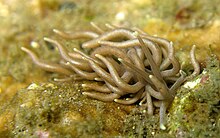Phyllodesmium
| Phyllodesmium | |
|---|---|
 |
|
| A live individual of Phyllodesmium briareum, head end towards the front | |
| Scientific classification | |
| Kingdom: | Animalia |
| Phylum: | Mollusca |
| Class: | Gastropoda |
| (unranked): |
clade Heterobranchia clade Euthyneura |
| Superfamily: | Aeolidioidea |
| Family: | Facelinidae |
| Subfamily: | Favorininae |
| Genus: |
Phyllodesmium acantochinum Ehrenberg, 1831 (1828) |
| Type species | |
|
Phyllodesmium hyalinum Ehrenberg, 1831 |
|
| Diversity | |
| 27 species (in this list) | |
| Synonyms | |
|
|
clade Euthyneura
clade Nudipleura
clade Nudibranchia
clade Dexiarchia
clade Cladobranchia
clade Aeolidida
Phyllodesmium is a genus of predatory sea slugs, aeolid nudibranchs, marine gastropod molluscs in the family Facelinidae.
These nudibranchs occur in the tropical Indo-Pacific Ocean and warm temperate waters of Japan, Tasmania and South Africa.
The nudibranchs in this genus often show extraordinary mimicry, each species very closely resembling its prey species, which are , a kind of soft coral.
Some of the species are also unusual in that they are able to utilize zooxanthellae from their prey, in a symbiotic relationship that provides them with extra nutrition from photosynthesis, hence they are commonly called "solar-powered" sea slugs (also see the Sacoglossa).
Species within the genus Phyllodesmium include:
Species of the genus Phyllodesmium are carnivorous and feed on (for example in the family Xeniidae). This is a unique feature within the Aeolidida.
...
Wikipedia
